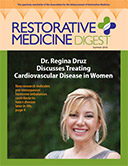Berberine is a highly versatile botanical with extensive physiological activity resulting from its ability to interact with numerous enzyme systems, receptor sites, and cell signaling pathways. Both pre-clinical and clinical studies continue to shed light on berberine's therapeutic potential, corroborating many of its traditional uses. Berberine has antioxidant and anti-inflammatory effects and can help regulate certain metabolic processes. For example, studies show that berberine may improve insulin resistance, support insulin secretion, inhibit lipogenesis, and rebalance the gut microbiome. The roster of novel molecular targets that berberine influences continues to be discovered, with its ability to regulate adenosine monophosphate (AMP) levels and induce AMP-activated protein kinase (AMPK) being chief among them. AMPK activity, which declines with age, is crucial for the proper functioning of cellular metabolism.1,2,3
Evidence for Berberine's Impact on Cardiovascular and Metabolic Health
Studies indicate that berberine has several anti-atherosclerotic effects, including improving endothelial dysfunction; and decreasing cholesterol aggregation, foam cell formation, and platelet aggregation.4 Many of these effects are thought to be mediated by berberine's influence on AMPK.5 An early experimental study of liver cells found that AMPK activation by berberine reduced the synthesis of both cholesterol and triglycerides.6 Berberine also has anti-atherosclerotic effects via other mechanisms in addition to AMPK activation. For example, it inhibits the PCSK9 enzyme, resulting in increased removal of LDL cholesterol from the blood.7
Berberine reduced both the oxidation of LDL cholesterol (oxLDL) and the production of reactive oxygen species stimulated by oxLDL, in human umbilical vein endothelial cells, thereby protecting against cytotoxicity.8 Several older studies described berberine's positive impact on dyslipidemia, for example, reducing levels of apolipoprotein B (a risk factor for cardiovascular diseases) by 13-15%,9,10 along with its ability to significantly lower fasting blood glucose levels and downregulate glycosylated hemoglobin A1c (HbA1c), in people with type 2 diabetes. In one clinical trial of 116 patients with type 2 diabetes, 1 gram of berberine per day reduced fasting blood glucose levels by 20%, and glycosylated HbA1c levels by 12%.11
A systematic review and meta-analysis of 14 studies published in 2012 suggested that berberine had comparable effects to certain oral hypoglycemic drugs, including metformin,12 whose own mechanism of action centers on AMPK.13 It is possible that berberine has hypoglycemic effects through a different mechanism than oral hypoglycemics, including upregulation of insulin receptor expression.14 A recent review suggests berberine may lower blood glucose through multiple mechanisms as well as via anti-inflammatory and antioxidant effects.15
Several more recent systematic reviews and meta-analyses confirm earlier findings, and further emphasize berberine's potential impact on metabolic disorders, such as promoting insulin secretion, improving insulin resistance by upregulation of receptors, inhibiting lipogenesis, decreasing fatty deposition in the liver,16,17 and improving the gut microbiota.18,19
Clinical Implications
A robust body of evidence supports the potential beneficial effects of berberine on various cardiometabolic conditions. These positive effects are likely augmented and more sustainable in conjunction with healthy lifestyle changes. Clinicians may want to consider including berberine and other botanicals that address cardiovascular and metabolic health through a variety of mechanisms in the overall treatment plan for patients with mild to moderate dyslipidemia.
References
- https://www.ncbi.nlm.nih.gov/pmc/articles/PMC5780224/
- https://www.ncbi.nlm.nih.gov/pmc/articles/PMC4973318/
- https://pubmed.ncbi.nlm.nih.gov/27887947/
- https://pubmed.ncbi.nlm.nih.gov/30466986/
- https://journals.plos.org/plosone/article?id=10.1371/journal.pone.0025436
- https://pubmed.ncbi.nlm.nih.gov/16508037/
- https://www.ncbi.nlm.nih.gov/pmc/articles/PMC9650693/
- https://pubmed.ncbi.nlm.nih.gov/18001034/
- https://www.ncbi.nlm.nih.gov/pmc/articles/PMC3832145/
- https://pubmed.ncbi.nlm.nih.gov/17341006/
- https://pubmed.ncbi.nlm.nih.gov/18397984/
- https://www.ncbi.nlm.nih.gov/pmc/articles/PMC3478874/
- https://pubmed.ncbi.nlm.nih.gov/22117616/
- https://pubmed.ncbi.nlm.nih.gov/19800084/
- https://www.ncbi.nlm.nih.gov/pmc/articles/PMC9709280/
- https://pubmed.ncbi.nlm.nih.gov/33186794/
- https://pubmed.ncbi.nlm.nih.gov/34956436/
- https://www.frontiersin.org/articles/10.3389/fcimb.2022.854885/full
- https://www.ncbi.nlm.nih.gov/pmc/articles/PMC7933196/
